Artificial Neural Network Interview Questions
Artificial Neural Network Interview Questions
1. Explain Neural Network?
Neural Network is a sequence of an algorithm that gives its best to recognize the underlying relationship in a data-set through a process. The artificial neural network has several differences from biological brains. These networks play a crucial role in deep learning.
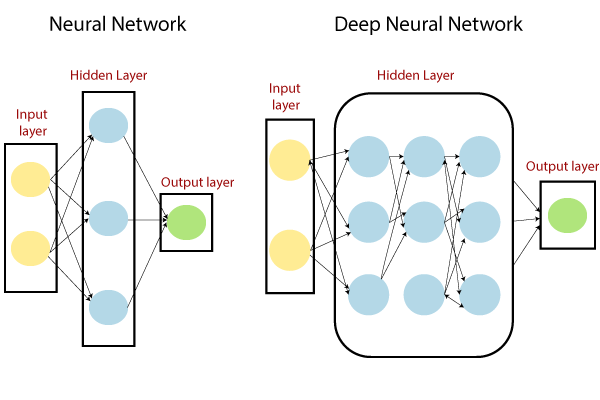
2. Explain Biological Neural Network and Artificial Neural network?
Biological Neural Network is prepared with the help of real neurons. Our nervous system is made via neurons and brain. A biological neural network is our nervous system in which neurons are linked with each other.
Human has a mind to understand and can operate any task in a particular situation, but how can a robot do that? For that purpose, an artificial brain is designed, which is known as Neural Network. The human brain has neurons to transfer the information or data. Similarly, the neural network has nodes to perform the task. Nodes are the mathematical functions.
3. What do you mean by combination function in Neural Network?
Combination function is the vector to scalar function where each non-input combines the value that is fed into neural network via synaptic connections from other units producing the net input. Most NN uses the following two types of combination function:
1. Linear Combination Function (as in MLPs)
2. Euclidean Distance Combination Function (as in RBF)
4. How can we count the layers in a neural network?
There are two ways of counting the layers.
1. We can count the layers in units.
2. Layers can be counted in weight also.
5. Explain cases and variables?
The vector value, which is present at one time for all input units in the neural network, is known as a case, e.g., pattern, sample, etc. A case includes target value and other possible information with input values. On the other hand, the vector value that appears different times for a single input is known as input variable or features.
6. Define Activation function?
To perform a task by a machine, a neural network must have active neurons. The activation function is used to decide whether a neuron is active or not. For this purpose, Activation Function calculates a weighted sum and further adding bias with it. Activation function's main task is to introduce non-linearity into the output of a neuron. The activation function in the mathematical form is given below:
net-input = ? (weight*input) + bias
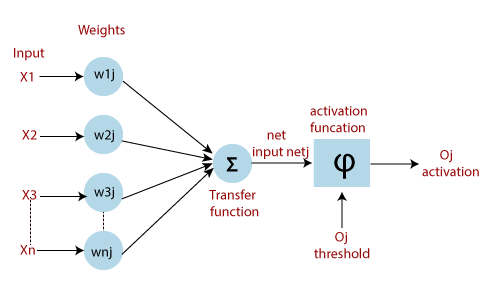
7. Explain Loss function?
Loss function in the network that depends on the adaptive parameters. These parameters are grouped into a single n-dimensional weight vector w.
Let see a diagram that describes the loss function f (w).
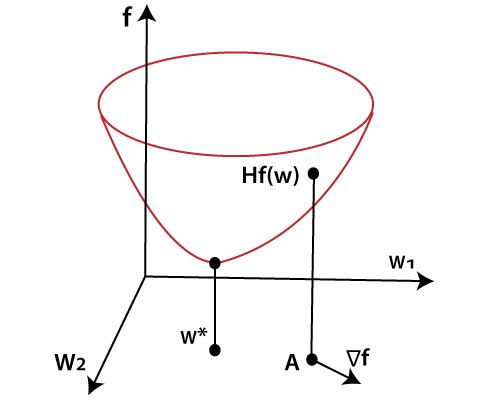
In the above diagram, at the point, w* minimum loss function occurs. We can find the first and second derivatives of the loss function at any point A. The elements of the first derivatives which are grouped in the gradient vector can be written as

For i= 0, 1, n.
Similarly, the elements of the second derivatives which are grouped in the Hessian matrix can be written as

For i, j= 0, 1…..
8. Explain different kinds of Kohonen networks?
There are three types of Kohonen networks, which are given below:
The Vector Quantization can be viewed as unsupervised destiny estimators. It is closely related to k-means cluster analysis.
The self-organizing Map gives a topology of mapping from the input space to the cluster. In SOM neurons are connected into a grid, i.e., two dimensional, three and more dimensional.
Learning Vector Quantization is used for supervised classification. In LQV, every codebook vector is assigned to one of the target class.
9. Is ANN similar to standard computers? Explain?
Artificial Neural Network is not similar to standard computers. The difference is that an artificial neural network is learned by example and performs its task, but standard computer perform their jobs which are based on algorithms. Standard computer learns nothing, but they work according to the algorithm.
10. How is ANN useful in making a machine intelligent?
Human has a mind to understand what is correct and what is incorrect, but how can machines do this? To make a machine intelligent, it is necessary that a machine can think like a human. For this purpose, an artificial neural network is designed to create a machine intelligent. An ANN is an artificial mind for the machine. ANN provides so many algorithms that help to train the machine's artificial mind
11. How can we help artificial neurons in learning?
There are two ways in which the artificial neurons can learn:
- The first step is associative mapping in which we work on the pattern with the given input and produce the pattern output.
- In the second step, units are learning. Learning of unit is essential to respond to particular properties of the input patterns.
12. What is the use of Artificial Neural Network?
Artificial Neural Network is developing for the robots. The reason for which ANN is implemented to give human thinking quality to robot, so it can be decided "what if" and "what if not" with precision.
Some of the other advantages are
- Adaptive Learning
- Self-organization Maps
- Real-Time Operation
13. What is bias?
We predict the output (y) based on a given input (x) in the neural network. We can create a model, i.e. (mx + c), which help the user to predict the result. When we train any model, it gets the appropriate value of the constants m and c.
This constant c is bias. Bias helps a model in such a way that it can fit best for given data. We can say bias gives freedom to act best.
14. Define Error function?
Most methods require a measure of the difference between the network output value and the target value to train supervised network. This measurement is done using the Error function. Error function plays a vital role in the training of a supervised network.
15. Explain Supervised and Un-Supervised learning?
Supervised learning is a learning technique in which we train and teach a machine using labeled data. Labeled data means some data which is already tagged with correct data. Supervised learning is completed under the guidance of a supervisor.
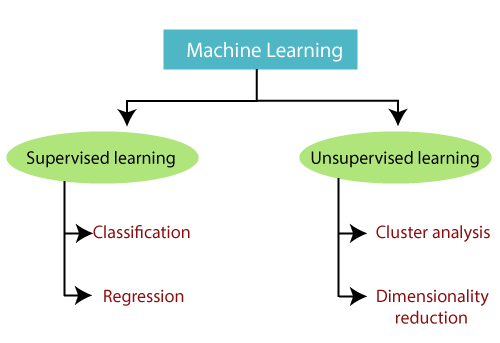
Figure: Classification of supervised and unsupervised learning.
Un-Supervised learning is a learning algorithm that trains the machine using data which is neither classified nor labeled. This learning algorithm is completed without the guidance of any supervisor. The machine is unable to find the hidden structure in unlabeled data.
16. Define the Hessian Matrix?
Second-order partial derivatives square matrix of a scalar is introduced to describe the local curvature of a multi-variable function which is known as the Hessian matrix. In neural network terminology, the Hessian matrix is the square matrix with the number of rows and columns equal to the total no of parameters in the neural network.
17. Which optimization algorithm is best in Neural Network?
If there are thousands of parameters in our neural network, then the gradient descent algorithm is the best one to save the memory. But if we have several neural networks to train with a few hundred parameters and a few thousands of instances, then Levenberg-Marquardt is the best algorithm.
18. Explain the use of Quasi-Newton Method over Newton’s Method?
Applications of Newton's method are costly in computation. To evaluate the Hessian matrix, it needs many operations to do. The Quasi-Newton method was developed to resolve the drawback of Newton's method. The iteration of algorithm builds up an approximation of inverse Hessian matrix rather than calculating it directly.
19. Explain Loss Index?
Loss Index is one important concept which plays a vital role in the training of a neural network. Loss index defines a task which is required to do by a neural network. A neural network is needed to learn the measure of the quality of the representation. The loss index provides this measure.
20. What is RBFNN?
RBFNN stands for Redial Basis Function Neural Network. It finds the distance at a point to the center, and it can smoothly work. Two layers exist in the RBF Neural Network. The features combine with the radial basis function in the inner layer. Features provide an output which is used in consideration.
21. Do you have any idea about the deep neural network?
The deep neural network is a network with an increased level of complexity. These deep neural networks are more than two layers. One of the primary use of these neural networks is dealing with unlabeled or unstructured data.
The deep neural network has an input layer, an output layer, and at least one hidden layer in between the input and output layer. Every layer can perform specific types of sorting and ordering in a process.
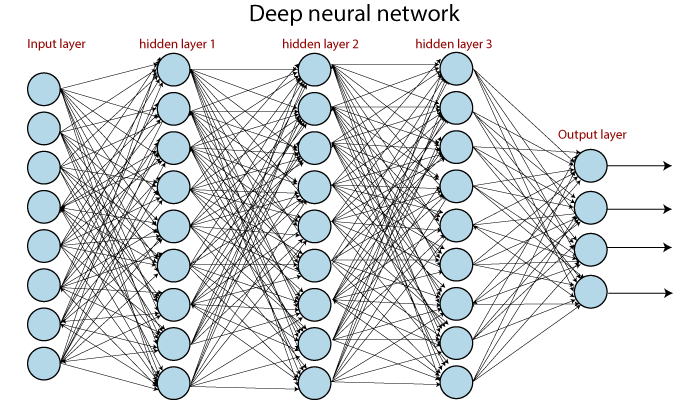
22. Explain the advantage of Artificial Neural Network?
There are various advantages of an artificial neural network which are given below:
1. In traditional programming, data or information is stored in a database, but, the data is stored in the whole network in the neural network.
2. The artificial neural network can work with incomplete knowledge. After providing the training data set to the model, it may produce output even without the complete information.
3. It is capable of parallel processing. The ANN has numerical strength which can perform more than one task at the same time.
4. The ANN has the potential for high tolerance. When the artificial neural networks are scaled across multiple machines and multiple servers. So, the neural network can route around the missing data or server and nodes that can't communicate.
5. The artificial neural network can learn from the examples and apply them when a similar event or task arises and make them work through the real-time event.
23. How many types of the artificial neural network used in machine learning?
The Neural networks are divided into parts based on the number of hidden layers. There are six types of artificial neural network which are currently used in machine learning are given below:
1. Feedforward neural network.
2. Radial basis functions neural network.
3. Kohonen self-organizing neural network.
4. Recurrent neural network.
5. Convolutional neural network.
6. Modular neural network.
24. Explain the feed-forward neural network?
The feed-forward neural network is an artificial neural network in which the nodes are not connected in the form of cycle. The feed-forward neural network is completely different from the recurrent network. This is the first and simplest type of artificial neural network. The data or input travels in one direction in this network.
It may or may not have the hidden layers. The feed-forward neural networks are responsive to noisy data and easy to maintain. The information or data flow in this network is left to right.
It is also known as the multi-layered network of neurons. The feed-forward neural network consists of the number of simple neuron-like processing units and organized in layers. Each unit in a layer is connected with all the units in the previous layer.

Figure: Diagram of the Feed-forward neural network.
25. What is the convolutional neural network?
The convolutional neural network is a class of deep neural network. It is similar to a feed-forward neural network. The application of the convolutional neural network is that it uses image processing which takes over the OpenCV in the field of computer vision.
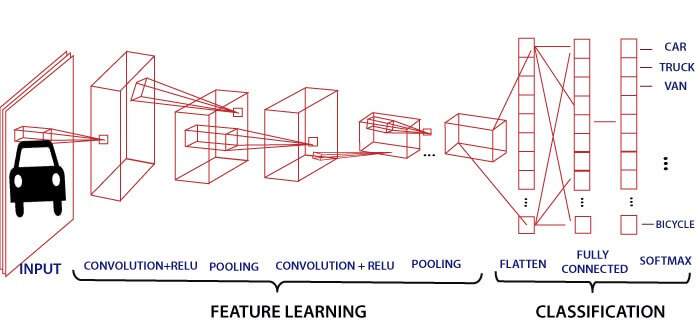
Figure: Diagram of the convolutional neural network.
The convolutional neural network is the deep learning algorithm which takes an input image, assigns importance to various aspects or objects in the image and differentiate one image from others. The architecture of this network is analogous to the connectivity patterns of neurons in the human brain

Comments
Post a Comment